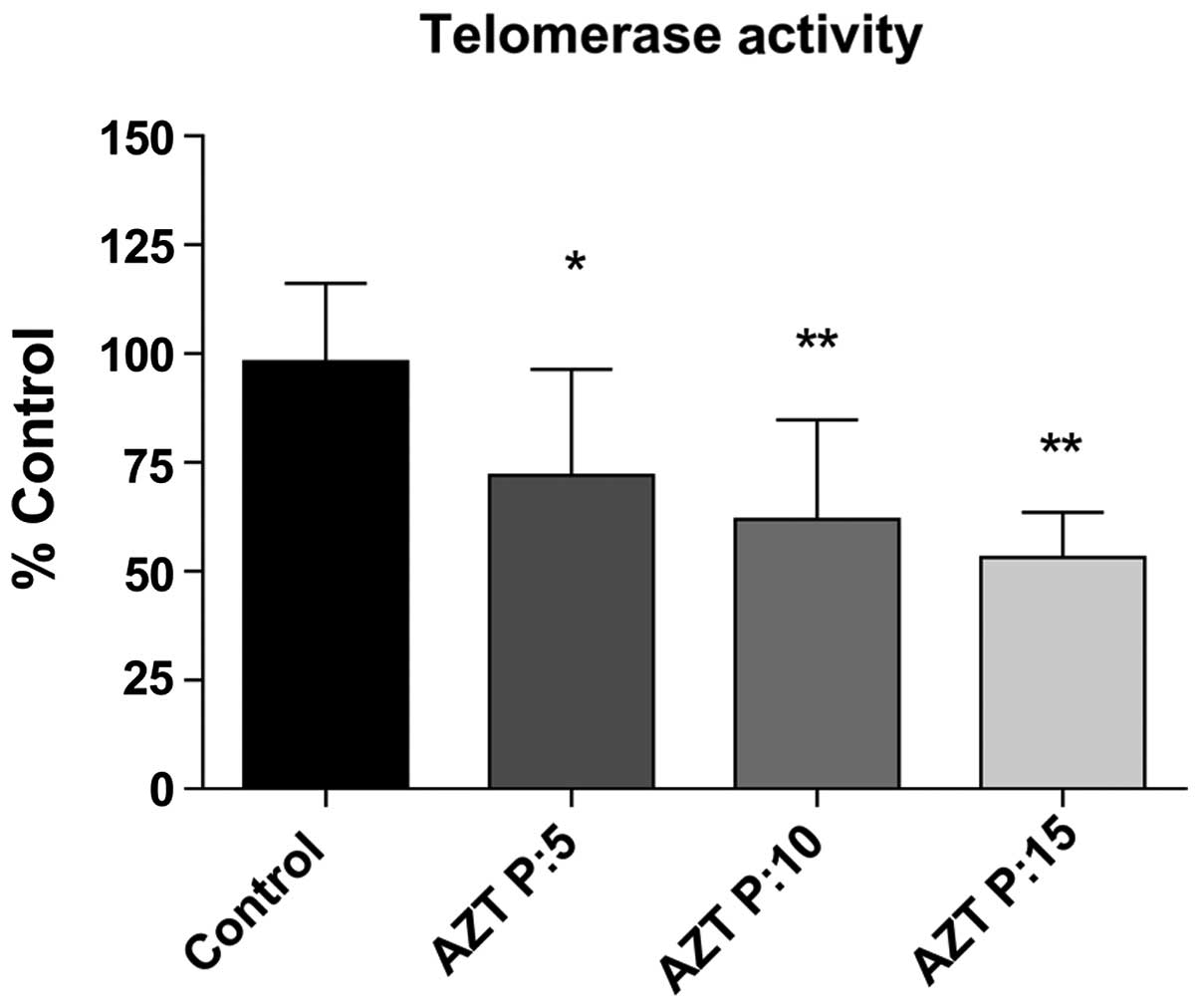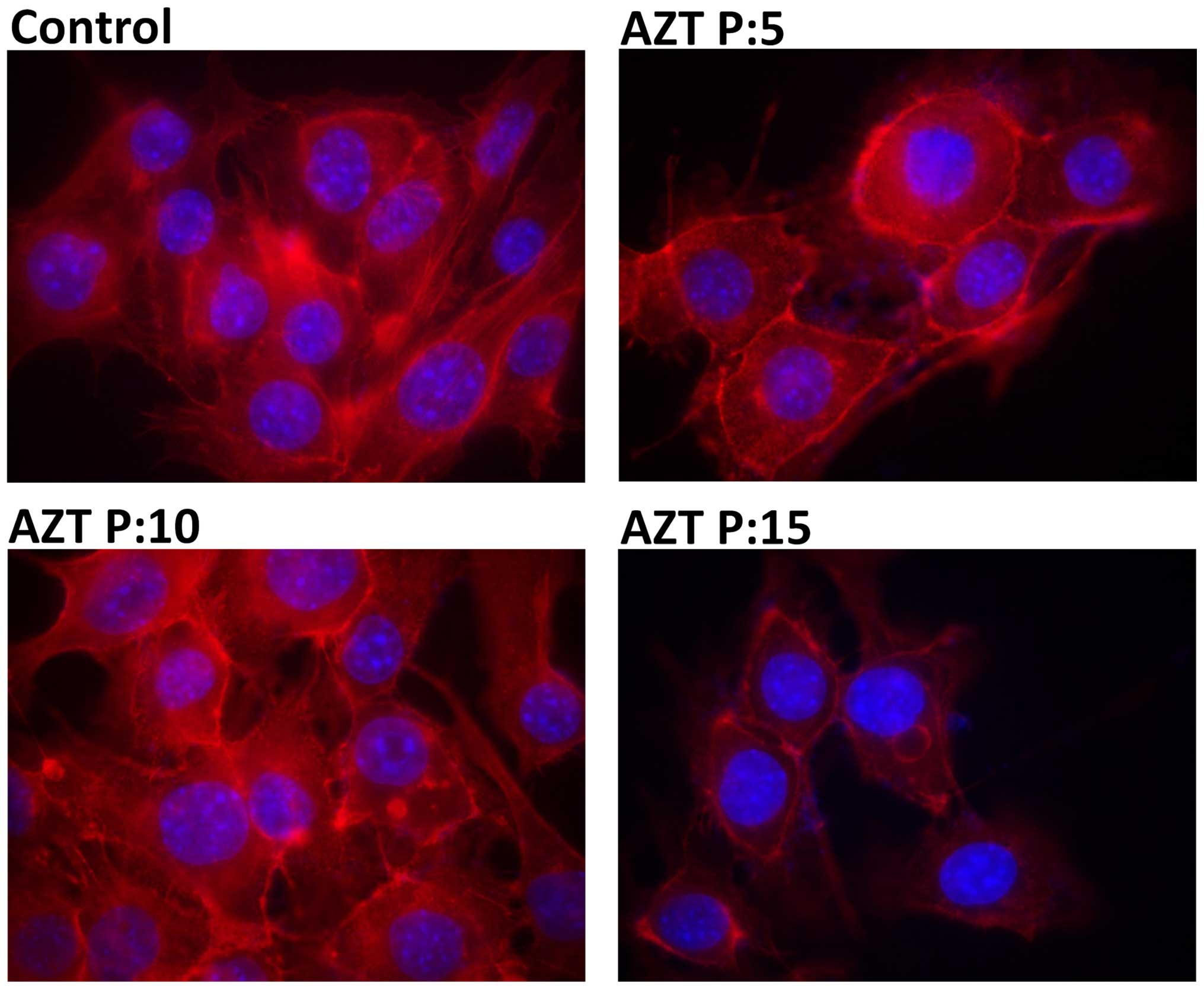|
1
|
Teralı K and Yilmazer A: New surprises
from an old favourite: The emergence of telomerase as a key player
in the regulation of cancer stemness. Biochimie. 121:170–178. 2016.
View Article : Google Scholar
|
|
2
|
Martínez P and Blasco MA: Replicating
through telomeres: A means to an end. Trends Biochem Sci.
40:504–515. 2015. View Article : Google Scholar : PubMed/NCBI
|
|
3
|
Gomez DE, Armando RG, Farina HG, Menna PL,
Cerrudo CS, Ghiringhelli PD and Alonso DF: Telomere structure and
telomerase in health and disease (Review). Int J Oncol.
41:1561–1569. 2012.PubMed/NCBI
|
|
4
|
Hájek M, Matulová N, Votruba I, Holý A and
Tloust'ová E: Inhibition of human telomerase by diphosphates of
acyclic nucleoside phosphonates. Biochem Pharmacol. 70:894–900.
2005. View Article : Google Scholar : PubMed/NCBI
|
|
5
|
Gomez D, Kassim A and Olivero O:
Preferential incorporation of 3′-azido-2′,3′-dideoxythymidine (azt)
in telomeric sequences of cho cells. Int J Oncol. 7:1057–1060.
1995.PubMed/NCBI
|
|
6
|
Gomez DE, Tejera AM and Olivero OA:
Irreversible telomere shortening by 3′-azido-2′,3′-dideoxythymidine
(AZT) treatment. Biochem Biophys Res Commun. 246:107–110. 1998.
View Article : Google Scholar : PubMed/NCBI
|
|
7
|
Tejera AM, Alonso DF, Gomez DE and Olivero
OA: Chronic in vitro exposure to 3′-azido-2′, 3′-dideoxythymidine
induces senescence and apoptosis and reduces tumorigenicity of
metastatic mouse mammary tumor cells. Breast Cancer Res Treat.
65:93–99. 2001. View Article : Google Scholar : PubMed/NCBI
|
|
8
|
Koh CM, Khattar E, Leow SC, Liu CY, Muller
J, Ang WX, Li Y, Franzoso G, Li S, Guccione E, et al: Telomerase
regulates MYC-driven oncogenesis independent of its reverse
transcriptase activity. J Clin Invest. 125:2109–2122. 2015.
View Article : Google Scholar : PubMed/NCBI
|
|
9
|
Park JI, Venteicher AS, Hong JY, Choi J,
Jun S, Shkreli M, Chang W, Meng Z, Cheung P, Ji H, et al:
Telomerase modulates Wnt signalling by association with target gene
chromatin. Nature. 460:66–72. 2009. View Article : Google Scholar : PubMed/NCBI
|
|
10
|
Martínez P and Blasco MA: Telomeric and
extra-telomeric roles for telomerase and the telomere-binding
proteins. Nat Rev Cancer. 11:161–176. 2011. View Article : Google Scholar : PubMed/NCBI
|
|
11
|
De Leonardis F, Monti L, Gualeni B, Tenni
R, Forlino A and Rossi A: Altered signaling in the G1 phase
deregulates chondrocyte growth in a mouse model with proteoglycan
undersulfation. J Cell Biochem. 115:1779–1786. 2014. View Article : Google Scholar : PubMed/NCBI
|
|
12
|
Li Y, Casey SC and Felsher DW:
Inactivation of MYC reverses tumorigenesis. J Intern Med.
276:52–60. 2014. View Article : Google Scholar : PubMed/NCBI
|
|
13
|
Alonso DF, Farías EF, Urtreger A, Ladeda
V, Vidal MC and Bal De Kier Joffé E: Characterization of F3II, a
sarcomatoid mammary carcinoma cell line originated from a clonal
subpopulation of a mouse adenocarcinoma. J Surg Oncol. 62:288–297.
1996. View Article : Google Scholar : PubMed/NCBI
|
|
14
|
Segatori VI, Otero LL, Fernandez LE, Gomez
DE, Alonso DF and Gabri MR: Antitumor protection by NGcGM3/VSSP
vaccine against transfected B16 mouse melanoma cells overexpressing
N-glycolylated gangliosides. In Vivo. 26:609–617. 2012.PubMed/NCBI
|
|
15
|
Chen YY, Wu XQ, Tang WJ, Shi JB, Li J and
Liu XH: Novel dihydropyrazole-chromen: Design and modulates hTERT
inhibition proliferation of MGC-803. Eur J Med Chem. 110:65–75.
2016. View Article : Google Scholar : PubMed/NCBI
|
|
16
|
Gomez DE, Armando RG and Alonso DF: AZT as
a telomerase inhibitor. Front Oncol. 2:1132012. View Article : Google Scholar : PubMed/NCBI
|
|
17
|
Ji HJ, Rha SY, Jeung HC, Yang SH, An SW
and Chung HC: Cyclic induction of senescence with intermittent AZT
treatment accelerates both apoptosis and telomere loss. Breast
Cancer Res Treat. 93:227–236. 2005. View Article : Google Scholar : PubMed/NCBI
|
|
18
|
Jin RR, Chao R, Xi YM, Chen C, Chu HY, Li
M and Zhang H: Effects of AZT on leukemia cell line KG-1a
proliferation and telomerase activity. Zhongguo Shi Yan Xue Ye Xue
Za Zhi. 20:277–281. 2012.PubMed/NCBI
|
|
19
|
Datta A, Bellon M, Sinha-Datta U,
Bazarbachi A, Lepelletier Y, Canioni D, Waldmann TA, Hermine O and
Nicot C: Persistent inhibition of telomerase reprograms adult
T-cell leukemia to p53-dependent senescence. Blood. 108:1021–1029.
2006. View Article : Google Scholar : PubMed/NCBI
|
|
20
|
Fang JL, McGarrity LJ and Beland FA:
Interference of cell cycle progression by zidovudine and lamivudine
in NIH 3T3 cells. Mutagenesis. 24:133–141. 2009. View Article : Google Scholar :
|
|
21
|
Olivero OA, Tejera AM, Fernandez JJ,
Taylor BJ, Das S, Divi RL and Poirier MC: Zidovudine induces
S-phase arrest and cell cycle gene expression changes in human
cells. Mutagenesis. 20:139–146. 2005. View Article : Google Scholar : PubMed/NCBI
|
|
22
|
Bretones G, Delgado MD and León J: Myc and
cell cycle control. Biochim Biophys Acta. 1849:506–516. 2015.
View Article : Google Scholar
|
|
23
|
Hassani S, Ghaffari SH, Zaker F, Mirzaee
R, Mardani H, Bashash D, Zekri A, Yousefi M, Zaghal A, Alimoghaddam
K, et al: Azidothymidine hinders arsenic trioxide-induced apoptosis
in acute promyelocytic leukemia cells by induction of p21 and
attenuation of G2/M arrest. Ann Hematol. 92:1207–1220. 2013.
View Article : Google Scholar : PubMed/NCBI
|
|
24
|
Abbas T and Dutta A: p21 in cancer:
Intricate networks and multiple activities. Nat Rev Cancer.
9:400–414. 2009. View
Article : Google Scholar : PubMed/NCBI
|
|
25
|
Wang H, Mannava S, Grachtchouk V, Zhuang
D, Soengas MS, Gudkov AV, Prochownik EV and Nikiforov MA: c-Myc
depletion inhibits proliferation of human tumor cells at various
stages of the cell cycle. Oncogene. 27:1905–1915. 2008. View Article : Google Scholar
|
|
26
|
Chen D, Huang J, Zhang K, Pan B, Chen J,
De W, Wang R and Chen L: MicroRNA-451 induces
epithelial-mesenchymal transition in docetaxel-resistant lung
adenocarcinoma cells by targeting proto-oncogene c-Myc. Eur J
Cancer. 50:3050–3067. 2014. View Article : Google Scholar : PubMed/NCBI
|
|
27
|
Shi JW, Liu W, Zhang TT, Wang SC, Lin XL,
Li J, Jia JS, Sheng HF, Yao ZF, Zhao WT, et al: The enforced
expression of c-Myc in pig fibroblasts triggers
mesenchymal-epithelial transition (MET) via F-actin reorganization
and RhoA/Rock pathway inactivation. Cell Cycle. 12:1119–1127. 2013.
View Article : Google Scholar : PubMed/NCBI
|
|
28
|
Bhushan B and Kush L: Pharmocophoric
studies of anti-telomerase drugs. Int J Innov Res Dev. 3:268–272.
2014.
|















